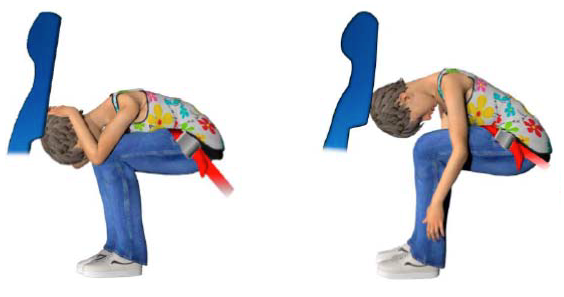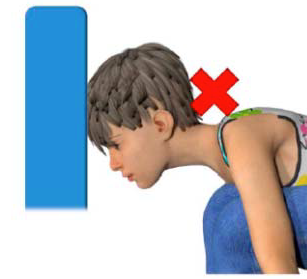What is the correct bracing position for an emergency?
The right bracing position is dependent on the seat location. It is therefore important for passengers to pay attention to the safety instructions given by the cabin crew and practice the brace method as directed. If in doubt, ask for guidance or refer to the airline’s safety information card. Always review the bracing methods before each take-off and landing, taking note of the following general guidelines:
For seats with ample leg room (seat or partition in front of you is beyond reach):
Sit as far back as possible;
Fasten your seat belt in a low position across your hips and tighten it firmly, ensuring that it is not twisted;
Place your feet together flat on the floor as far back toward the seat as possible;
Tuck your chin inwards towards your chest;
Lean forward as far as possible with your chest as close as possible to your knees;
Either place your hands on top of your head or place arms at sides of lower legs or hold on to your lower legs and keep your head as low as possible; and
Always keep your head down and remain in bracing position until directed otherwise by the cabin crew members.
For seats with limited legroom (seat or partition in front of you is within reach):
Sit as far back as possible;
Fasten your seat belt in a low position across your hips and tighten it firmly, ensuring that it is not twisted;
Place your feet together flat on the floor as far back toward the seat as possible;
Tuck your chin inwards towards your chest;
Lean forward as far as possible;
Place head against the seatback of the seat in front or any sturdy partition that may be in front of you;
Place your hands on the top of your head and keep your arms as close as possible to the sides of your face; and
Keep your head down and cradled in your arms and remain in bracing position until directed otherwise by the cabin crew member.


Illustrations extracted from ICAO Doc 10086-Manual on Information and Instructions for Passenger Safety
These are general bracing techniques. Airlines' cabin crew, when required, will provide detailed guidance to passengers on the bracing methods, bearing in mind the specific needs of some passengers, e.g. pregnant mothers or mothers with babies. Also, passengers should note that besides knowing how and when to brace, they must also ensure that their seat belt is correctly fastened, their seat back is upright, and their tray table, video screen and footrest are stowed in an emergency.